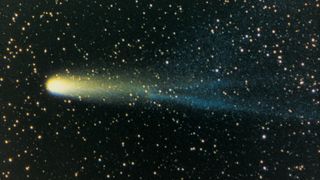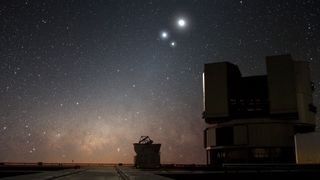What was the Star of Bethlehem?
The Star of Bethlehem probably wasn't a star.

As the well-known story in the Gospel of Matthew goes, the Star of Bethlehem guided three Magi, or wise men, to Jerusalem some 2,000 years ago. And after consulting with King Herod of Judea, the men found newborn baby Jesus in the little town of Bethlehem. Whether such an event really happened in history is difficult to prove, but if it did, what was the Star of Bethlehem?
This is a question scholars have long pondered, not just from a religious or historical perspective, but from a scientific one, too. Plenty of theories have been proposed, from an astronomical event to an astrological horoscope, but thanks to modern astronomy, scientists are getting closer to an answer.
"If what is in the New Testament is a historical account of something, then that historical account requires an explanation," David Weintraub, a professor of physics and astronomy at Vanderbilt University in Tennessee, told our sister publication All About Space in an email. "As an astronomer, you want an astronomical explanation."
The Star of Bethlehem wasn't a comet or a supernova
We know that Halley's Comet was visible in the sky in 11 B.C. However, as the Magi trekked toward Jerusalem and on to Bethlehem, it seems unlikely that they followed a comet because its position would have changed as the Earth rotated, so the comet would not have led them in a single direction. What's more, in the ancient world, comets were often regarded as bad omens.
"For Christmas cards, it makes a nice picture having a comet and a tail but in those days comets up in the sky were usually a harbinger of impending disaster," Grant Mathews, a professor of theoretical astrophysics and cosmology at the University of Notre Dame in Indiana, told All About Space in an email.
We can also rule out novas and supernovas. Either event would have resulted in a detectable remnant, but astronomers have not found anything that might date back to this time.
Furthermore, had the Magi followed one, they probably would have walked in a circle. "You can't follow a star from Baghdad to Jerusalem to Bethlehem," Weintraub said. "Stars don't do that. They rise and set, and they don't sit in the sky."
Such an event would surely have been seen by others at the time, too. Although novas are reportedly quite rare, you'd still expect to find other historical accounts of a large, bright event in the sky.
Other theories suggest a supernova in the Andromeda galaxy as the cause, as described in a 2005 study published in the journal The Observatory. Although it's possible to see the galaxy with the unaided eye, it wouldn't have been possible to see a star going supernova and exploding within it — even with the help of a telescope.

The "star" could have been an entire sky of stars
This leads us to one of two possibilities. The first is that the Magi were making an astrological interpretation of the sky. The fact that they needed to ask Herod for directions when they arrived suggests they were not being led to their final destination by a single bright object.
Astrology was widely used at the time, and with the Magi coming from Babylon, it's plausible that they were astrologers. And due to a particular alignment of planets and stars, they may have read a hidden meaning among the stars, leading them to King Herod. For example, Jupiter's display could have been of great significance here, as astrology associated the planet Jupiter with royalty, so the moon passing it in the constellation of Aries on April 17, 6 B.C. could have heralded the birth of Christ.
"Modern astronomers don't put any credence in astrology, but 'modern' is important in this context," Weintraub said. "What's important is what people thought 2,000 years ago. Astrology was a big deal back then. The explanation I have found that makes the most sense is that it was astrological."
The Star of Bethlehem could have been a conjunction

The other — more astronomical — explanation is that there was indeed a bright object in the sky — a conjunction between planets and stars. A conjunction occurs when two or more celestial bodies appear to meet in the night sky from our location on Earth. These events can continue every night in a similar location for days or weeks. If the wise men were to follow the moment of conjunction, it's possible they would have been led in a specific direction.
Astronomer Michael Molnar suggested that a conjunction theory might be correct in his book "The Star of Bethlehem" (Rutgers University Press, 1999). If the "star" was the result of a conjunction (and this historical event did really happen), then there are several different alignments that could be the culprit.
Perhaps the most promising, and the one favored by Mathews, is an alignment of Jupiter, Saturn, the moon and the sun in the constellation of Aries on April 17, 6 B.C. This conjunction fits with the story for a few reasons. First, this conjunction happened in the early morning hours, which aligns with the Gospel's description of the Star of Bethlehem as a rising morning star. The Magi also lost sight of the star, before seeing it come to rest in the place where baby Jesus lay in the stable. This could have been the result of the retrograde motion of Jupiter, which means that it appears to change direction in the night sky as Earth's orbit overtakes it.
"Normally, planets move eastward if you're following them in the sky," Mathews said. "But when they go through retrograde motion, they turn around and go in the direction that the stars rise and set at night [westward]."
Two other conjunctions around a similar time also look promising. One is the meeting of Jupiter, Venus and the star Regulus in the constellation of Leo on June 17, 2 B.C. Without the aid of a telescope, the two planets would appear as a single "star," brighter than Venus and Jupiter individually. Another conjunction occurred in 6 B.C., between Jupiter, Saturn and Mars in the constellation of Pisces. But neither of these latter two conjunctions match the description in the New Testament as closely as the conjunction that occurred on April 17, 6 B.C.
The Star of Bethlehem mystery continues
Although scientists have ruled out several possibilities, we may never know for sure what the Star of Bethlehem was or if it even really happened, barring some remarkable archaeological findings. But it's a question that comes up year after year, and it will continue to pique the interest of scientists and historians alike for many years to come.
"Nothing in science is ever case closed, nor is it in history," Mathews said. "We may never know if the Star of Bethlehem was a conjunction, astrological event or a fable to advance Christianity. Maybe it was simply a miracle."
Additional resources
Explore whether astronomy can explain the biblical Star of Bethlehem with this article from The Conversation. Discover more theories behind the Star of Bethlehem with Royal Museums Greenwich. Read about what the magi had in common with scientists in this article from The Conversation.
Bibliography
- Michael R. Molnar. The Star of Bethlehem: The Legacy of the Magi. Rutgers University Press, Sept, 1. 1999.
- van Kooten, George H., and Peter Barthel, eds. The Star of Bethlehem and the Magi: interdisciplinary perspectives from experts on the ancient Near East, the Greco-Roman world, and modern astronomy. Brill, 2015.
- Kelley, David H., and Eugene F. Milone. Exploring ancient skies: A survey of ancient and cultural astronomy. New York: Springer, 2011.
- Coates, Richard. "A linguist's angle on the Star of Bethlehem." Astronomy & Geophysics 49.5 (2008): 5-27.
- Hughes, David W. "The Star of Bethlehem." Nature 264.5586 (1976): 513-517.
- Tipler, Frank J. "The Star of Bethlehem: a type Ia/Ic supernova in the Andromeda galaxy?." The observatory 125 (2005): 168-174.
Join our Space Forums to keep talking space on the latest missions, night sky and more! And if you have a news tip, correction or comment, let us know at: community@space.com.
Get the Space.com Newsletter
Breaking space news, the latest updates on rocket launches, skywatching events and more!

Jonathan O’Callaghan is a freelance space and science journalist based in the UK, regularly writing and reporting for a number of publications around the world. He specialises in covering commercial spaceflight, space exploration, and astrophysics, but also reports across a wide range of science, from CRISPR to climate change.
- Daisy DobrijevicReference Editor
